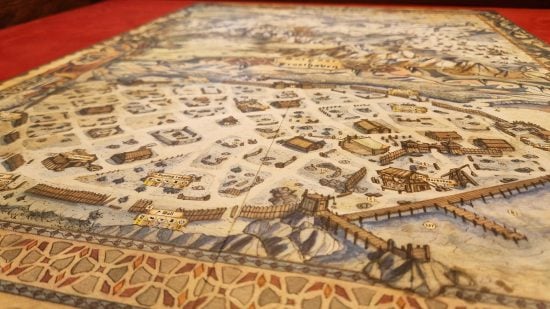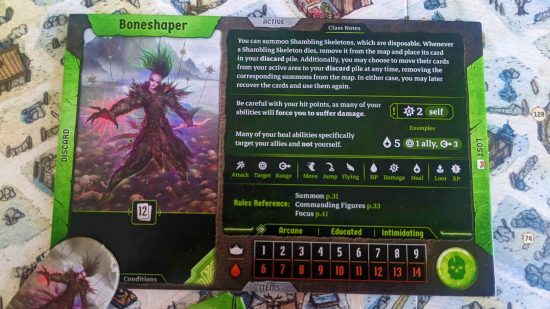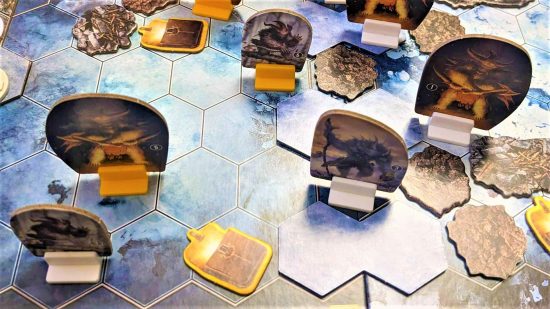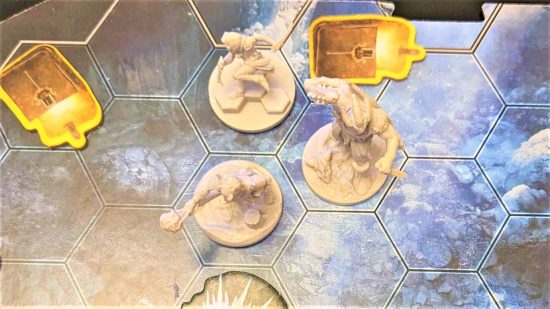Our Verdict
Frosthaven is a hefty box with an eye-watering price tag and an overwhelming amount of content. It’s also an addictive dungeon-crawler that improves on Gloomhaven in many ways. It’s not for everyone, but it is for me – and I can’t stop playing.
I’d like to apologize to every board game I’ve played this year. I may have been playing you, but I was thinking about Frosthaven the entire time.
Ever since my review copy arrived, Frosthaven has consumed my every waking thought. It has consumed my dreams. It has consumed my living room. Long story short, it’s a fantastic game that’ll undoubtedly join the ranks of our best board games list very soon.
That being said, no game is completely perfect. Frosthaven comes with a price tag as big as its 30 lbs box, so you’ll want to be sure you adore it before you invest. And, with a fresh print run available as part of Cephalofair’s Backerkit campaign on June 20, now’s the time to decide.
This Frosthaven review aims to give a thorough (but spoiler-free) look at how the game plays – and whether it’s worth picking up.
What is Frosthaven?
Frosthaven is a standalone sequel to the groundbreaking dungeon-crawler, Gloomhaven. Like its older sibling, Frosthaven is a co-op board game where one to four players use their characters’ unique decks of cards to complete dungeon scenarios.
Each turn, players must play two cards, using the top ability for one and the bottom for the other. Combat is modified by decks of cards instead of dice to reduce randomness (something that’s also being carried over to the Gloomhaven RPG).
Each character starts the game hidden in a sealed tuck box. As your campaign progresses, you’ll unlock more secrets, adding permanent stickers and marks to a world map that documents your journey.
While Frosthaven shares the same DNA as Gloomhaven, a lot has changed. The most obvious addition is the outpost of Frosthaven itself.
Players will now complete an outpost phase when they return after scenarios, allowing them to craft items and construct buildings. Frosthaven develops alongside the characters – even getting its own character sheet.
As well as new content, Frosthaven features a heap of tweaks. Many small rules have been added or adjusted to enhance the game and improve quality of life. Designer Isaac Childres told Wargamer that Frosthaven learned plenty of lessons from Gloomhaven, and this is evident in everything from the game’s rules to the box design.
Each of the Gloomhaven classes has been replaced with a brand-new roster. There are six starting classes in Frosthaven, with plenty more to unlock as you progress. Frosthaven also includes over 130 new scenarios to explore. One noticeable change here is a shift in complexity: overall, the classes and campaign in Frosthaven seem more challenging than Gloomhaven.
Who is Frosthaven for?
While it’s totally possible to play Frosthaven if you’ve never touched Gloomhaven, you’ll face a far steeper learning curve than veterans of the series. The higher difficulty and wealth of new content make this a perfect game for people who already love Gloomhaven – or at least love a challenge.
The price tag also makes this a less appealing game for newcomers. With the initial Kickstarter charging $250 (£195), Frosthaven is not a cheap board game.
Gloomhaven itself can often be bought for a discount these days (though with a second edition on the way, you may want to wait). Plus, the more condensed Gloomhaven: Jaws of the Lion costs $50 (£50) at best. This shorter, smaller board game remains the best introduction to Gloomhaven’s world – and the recommended starting point of creator Isaac Childres (I should know; I asked him).
Frosthaven is huge. It’s expensive. It’s also long. Even with small player groups, the setup, scenario, and outpost phase demand several hours of your time. A campaign could take months (or years) to complete. And since this is a legacy board game, you’ll likely only get to do it once.
Playing Frosthaven is like meeting your true love. It requires an enormous amount of commitment, and there are plenty of challenges to face. But if you’re dedicated, you could be rewarded with the experience of a lifetime.
Is Frosthaven good or bad?
Before I tally up the strengths and weaknesses of the game, it feels important to describe exactly how I played Frosthaven, as there are many features which may impact how I feel about the game. For the record, I am playing Frosthaven’s solo mode using a four-character party at the recommended difficulty levels.
Frosthaven setup
Not to be dramatic, but the setup for Gloomhaven was the stuff of nightmares. Without an unofficial divider (which meant handing over even more cash), sorting tokens and setting up scenarios could take as long as the dungeon itself.
You’ll still need to schedule half a day just to punch out the cardboard contents of Frosthaven. However, Cephalofair now provides token containers, storage bags, and dividers. The box even comes with its own, separate instruction manual. My first reaction upon opening the box was an enormous sigh of relief.
My next emotion was childish excitement. Setting up Frosthaven introduced me to everything that was new and shiny in the sequel.
Advent-calendar-style boards, where you open little doors to reveal something new, help you track your campaign and brew potions. As well as new mechanics, the rulebook also contains blank spaces – as you’ll be earning stickers to place there as well as on your Frosthaven map. Frosthaven offers a tactile and gleeful experience, as all good legacy games should.
Yes, the Frosthaven setup experience is a lot. The rulebook is laid out well, but there are still 80 pages to digest. And several hours to essentially build your board game could be grueling for some. I actually found the experience oddly therapeutic, and the hope of what I’d discovered during setup drove me towards my goal: beginning a game.
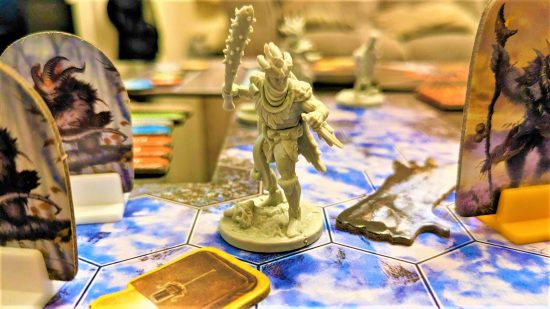
Frosthaven classes
With only two ‘low complexity’ classes available, Frosthaven starts as it means to go on. The simpler Frosthaven classes are still fun to play, but the denser options have far more ‘wow’ factor. Each has a unique identity and the potential for some really satisfying combat combos.
The core mechanic of choosing what ability cards to combine each round was what made Gloomhaven great. In Frosthaven, this puzzle remains intriguing, dynamic, and exciting.
However you like your dungeon crawl, there’s plenty of variety. The starting classes offer a range of playstyles, and each character can be further customized when choosing what to add to their ability decks after a level-up.
The levels of customization also enhance the part of Frosthaven that takes inspiration from tabletop RPGs. After tweaking a character to my heart’s content for five levels or so, I was saddened to retire them and create a new one – despite the multiple benefits of doing so.
Frosthaven’s starter classes feel more challenging overall, but they also feel more approachable. This is as much about the game’s components as how the classes play.
The very first page of the rulebook gives you an overview of your class choices, allowing you to decide from the get-go how complex you want play to be. The character boards have also been redesigned to give helpful rules reminders unique to each class. There are even some novel new details on there too, like personality traits which can affect the outcome of road events in-game.
Frosthaven scenarios
Frosthaven features all-new scenarios, but gameplay is mostly the same. There are a fair few rules adjustments, but these are fine details on the Frosthaven cake. One of the biggest changes is the new loot deck – since crafting is now a thing, you’ll be picking up a lot more loot to source components.
In keeping things familiar (and compatible with certain parts of Gloomhaven), Frosthaven does have one flaw. It’s still heavy on the admin, expecting you to track rounds, element potency, initiative orders, and more. This makes it quite easy to forget minor features of the game.
Frosthaven scenario objectives are highly varied (it’s not all ‘kill all enemies’ in the frozen wastes). Dungeons can get difficult, but you’ll want to punch the air when you finally beat a scenario. The boss fights I’ve encountered have been particularly creative puzzle-solving exercises.
Not every scenario is a diamond in the snow, though. I’ve not finished the game, but I’ve already encountered at least one disappointing dungeon that felt repetitive and unnecessarily tough.
Frosthaven dungeons can take some serious time to crawl, and you might need multiple tries to achieve an objective. It can feel frustrating to sink days into a scenario you can’t beat, but one thing helps soften the blow: Frosthaven itself.
The Frosthaven outpost
Every time you return to Frosthaven, a certain chain of events happens. Time passes on a calendar, sometimes triggering small story events. Random events could grant bonuses or send the outpost’s citizens into battle. And you’ll have some downtime to level up, brew potions, craft items, and construct buildings.
This phase is a chance to experience more of Frosthaven’s world (which feels like it has more nuance than its predecessor). You can also upgrade your party, uncover more scenarios to explore, and enhance the buffs you gain from the outpost. It tempers the frustration of continually losing a scenario, offering you different kinds of rewards simply for playing.
Is Frosthaven worth it?
Despite singing its praises, I’m hesitant to start knocking on doors and recommending Frosthaven to everyone. It’s amazing, but Jaws of the Lion is still a better gateway game. It’s addictive, but it’s still an enormous time commitment that costs $250.
Not everyone has the time, faith, or money for a game like Frosthaven. And that’s fine – everyone’s true love looks different. Frosthaven isn’t for everybody, but it’s going to make a certain type of person very, very happy.





